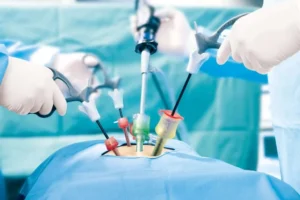Common Myths and Facts about Laparoscopic Surgery

As laparoscopic surgery provides a minimally intrusive alternative to open surgery, it has revolutionized modern medicine. Despite its many advantages, there are many misconceptions about it, which unnecessarily worry patients. This blog attempts to debunk the common myths about laparoscopic surgery and provides correct information to allow patients to make informed decisions.
What is Laparoscopic Surgery?
Laparoscopic surgery, also known as keyhole surgery, is a small incision operation involving tiny incisions to place a camera and surgical instruments. It enables the surgeon to perform precise procedures with minimal trauma to the adjacent tissues. It is used in high volumes for gynecology, urology, gastroenterology, and general surgery.
Myth 1: Laparoscopic Surgery is Riskier than Open Surgery
Fact: Laparoscopic surgery is safer in the majority of cases.
One of the most common myths is that laparoscopic surgery is riskier than open surgery. The minimally invasive surgery cuts down on complications like excessive blood loss, infection, and the length of hospitalization. Since the cuts are minor, there are fewer chances for post-operative complications, which makes it safer for most patients.
Myth 2: It is More Painful than Traditional Surgery
Fact: Patients experience less pain and discomfort after laparoscopic surgery.
Because laparoscopy has more minor cuts, it causes less body trauma, less nerve damage, and less pain after the surgery. Patients also require fewer analgesics than open surgery, resulting in easier recovery.
Myth 3: Laparoscopic Surgery Takes Longer to Perform
Fact: While it may take slightly longer, overall recovery is much faster.
Laparoscopic surgery requires specialized instruments and a high level of precision, which can make the procedure slightly longer than traditional surgery. However, the reduced hospital stay, faster wound healing, and minimal post-operative complications make it a more efficient option in the long run.
Myth 4: Recovery is Not Much Faster than Open Surgery
Fact: Patients recover significantly faster.
As laparoscopic surgery is minimally intrusive, it allows for faster recovery times. In contrast to the weeks or months needed for open surgical recovery, patients can frequently return to their regular activities in a matter of days to a week. The shorter hospital stay also decreases the overall cost of healthcare.
Myth 5: Laparoscopic Surgery is Only for Simple Procedures
Fact: It is widely used for complex surgeries as well.
Initially, laparoscopic surgery was used for simple procedures such as gallbladder removal and appendix removal. However, advancements in technology have made it a preferred approach for hernia repair, colorectal surgeries, bariatric procedures, gynecological surgeries, and even cancer treatments.
Myth 6: It is More Expensive than Open Surgery
Fact: The overall cost is often lower.
Laparoscopic surgery may be more expensive initially because it requires specialized training and sophisticated equipment, but over time, it is a more cost-effective option because it drastically cuts down on recovery time, post-operative care costs, and hospital stays.
Myth 7: Laparoscopic Surgery is Not as Effective as Open Surgery
Fact: It offers similar or even better outcomes than open surgery.
Many people believe that open surgery provides better results, but studies have shown that laparoscopic procedures offer equal or superior success rates. In addition, it leads to fewer complications, better cosmetic results (minimal scarring), and faster healing.
Myth 8: Not Everyone Is a Candidate for Laparoscopic Surgery
Fact: Most patients are candidates for laparoscopic surgery.
Though there are certain conditions where open surgery is necessary, most patients can be treated by laparoscopic surgery, even obese patients, patients with a history of previous abdominal surgeries, and some long-standing diseases. A skilled surgeon can determine if laparoscopic procedure is possible depending on the history of the patient and the level of complexity of the procedure.
Myth 9: Laparoscopic Surgery Makes Big Scars
Fact: It causes minor scarring.
In contrast to conventional surgery, in which enormous incisions are created, laparoscopic surgery translates to small keyhole incisions, resulting in small scars, improved cosmetic results, and less wound complications.
Myth 10: Laparoscopic Surgery Increases the Risk of Infection
Fact: It decreases the risk of infections.
Because laparoscopic procedures entail fewer cuts and less exposure of the internal organs, there are fewer opportunities for surgical site infection (SSI) than in open surgery. This renders it more favorable for patients with compromised immune systems or chronic illnesses.
Benefits of Laparoscopic Surgery
Now that we’ve debunked the common myths and facts about laparoscopic surgery let’s take a quick look at its benefits:
- Minimally invasive – Smaller incisions result in less pain and faster recovery.
- Reduced blood loss – Minimizes complications during and after surgery.
- Shorter hospital stays – Most patients are discharged within a day or two.
- Lower risk of infection – Due to reduced exposure of internal organs.
- Minimal scarring – Better cosmetic results compared to open surgery.
- Faster return to daily activities – Allows patients to resume their routine quicker.
Conclusion
Laparoscopic surgery has transformed surgical care, offering faster recovery, less pain, and minimal scarring. Despite its benefits, there are many myths and facts about laparoscopic surgery. A common myth is that it’s only suitable for minor procedures, but the fact is it’s used for complex surgeries like hernia repair and gallbladder removal.
Lux Hospitals specializes in advanced laparoscopic surgeries with expert care and advanced technology. Consult our specialists to explore the best surgical options for you. If you enjoyed this blog post, then do share it with others who would find the real story behind laparoscopic surgery useful to know!
Frequently Asked Questions
Laparoscopic surgery is used to diagnose and treat a variety of urologic, gynecologic, and abdominal conditions with fewer incisions, which leads to a quicker recovery, less pain, and fewer complications. Laparoscopic procedures are frequently used for weight loss surgery, appendectomy, gallbladder removal, hernia repair, and endometriosis.
A camera (laparoscope) and specialized surgical tools are placed via tiny incisions during laparoscopic surgery. The surgeon minimizes tissue damage, pain, and recovery time by performing the treatment precisely while seeing the inside organs on a monitor.
The cost of laparoscopy varies depending on the procedure type, hospital, surgeon’s expertise, and location. It typically ranges from ₹30,000 to ₹1,50,000 in India.
Yes, laparoscopic surgery is generally safer because it involves smaller incisions, leading to lower risks of infections, minimal blood loss, and faster recovery.
No, laparoscopic surgery typically causes less pain than open surgery due to smaller incisions and reduced trauma to surrounding tissues.
Most patients can return to their regular activities in a few days to a week, though recovery timeframes vary based on the surgery.
The initial cost may be higher due to specialized equipment, but the shorter hospital stay and faster recovery make it more cost-effective in the long run.
No, it actually lowers the risk of infection since it involves smaller incisions and minimal exposure of internal organs.




















